|
Key Takeaways:
- Millions of children experience mental disorders, with the most common being attention-deficit hyperactive disorder, depression, and anxiety.
- Parents can support their children’s mental health by creating a nurturing home environment, collaborating with their school, and encouraging their interests.
- If a child’s mental illness becomes detrimental to their daily living, it’s best to consult a mental health professional for advice.
|
Mental health issues in children can be challenging to identify, especially when they struggle to express themselves. Thus, it’s important to understand children’s mental health to provide the right support.
This guide will help parents and teachers understand the warning signs of a mental illness and provide tips for supporting children’s mental health.
Children’s Mental Health - An Overview
Good mental health improves a child’s ability to thrive in the real world and face problems as they arise. Factors like family relationships, significant life events, physical illness, and social relationships can influence a child’s mental health.
Childhood is a critical stage for influencing the state of an individual’s mental health. Nearly 20% of children between 3 and 17 in the United States become afflicted with a mental illness at any given time [*]. These mental illnesses can occur as a result of genetics, trauma, or other environmental causes.
Safe and stable environments can drastically improve a child’s mental health, and seeking early intervention is essential to providing children with the right opportunities to grow and thrive.
Common Childhood Mental Health Issues
-
Anxiety: According to the Center for Disease Control and Prevention, 10% of children between 3 and 17 are diagnosed with anxiety in the United States [*]. Contributing factors like genetics, environment, brain chemistry, and trauma can cause anxiety symptoms like constant worrying, separation anxiety, extreme phobias, and irritability.
-
Attention-Deficit Hyperactive Disorder (ADHD): ADHD is the most common childhood neurodevelopmental disorder, with about 9% of children under 17 affected [*]. For a child to become diagnosed with ADHD, they must display at least six symptoms, which should be present for a few months at minimum. Symptoms include an inability to focus, constantly fidgeting or moving, struggling with impatience, and forgetting things.
-
Depression: 3% of children experience depression, and it is most common in children aged 12 to 17 [*]. Children with depression experience persistent sadness, sleeping too much, low energy levels, changes in appetite, and a loss of interest in their favorite activities.
-
Eating disorders: Eating disorders are behavioral conditions that manifest in unhealthy eating habits. Anorexia nervosa is the most common of these disorders—it presents in self-starvation and has a high mortality rate. Warning signs to monitor include constant faintness, depression and irritability, heartburn, and irregular menstrual periods.
-
Bipolar Disorder: Bipolar disorder is most common in adolescents aged 13 to 18, and 2.9% of adolescents in the United States become diagnosed. Globally, 1.8% of children have pediatric bipolar disorder. [*]. Children with bipolar disorder experience mania, followed by depression.
Tips to Support Your Children’s Mental Health
Without support, mental disorders in children can persist into adulthood and make it challenging to succeed in different aspects of life. Thus, parents need to intervene early and provide ongoing support. Here’s what you can do.
1. Family counseling
When a child struggles with their mental health, every family member should know how best to support them. Family counseling is an excellent avenue for strengthening the family unit and learning healthy coping mechanisms together.
Families can achieve a more positive and stable home environment through improved communication, breaking down family dynamics, and parenting skills development.
2. Enroll in a parent training program
Sometimes, parents struggle to manage more challenging behaviors in their children and can benefit from a parent training program. These programs help parents respond to their child’s behaviors effectively and productively.
Over several sessions, parents will learn to address disruptive behaviors, improve communication with their child, and determine the healthiest methods of discipline.
3. Collaborate with your child’s school
For children to improve their well-being, they require an all-around supportive network—that includes their school environment. Communicating with your child’s teachers provides opportunities for early intervention and gives you a better understanding of their progress.
Parents and teachers can also work together to develop educational accommodations, such as individualized education plans (IEPs) or Section 504 plans.
4. Practice coping mechanisms at home
Life’s challenges are unavoidable and often out of our control, but equipping your child with healthy ways to respond to stressors can make them more resilient. You can teach them coping mechanisms by modeling them and experimenting with different techniques.
Discover what works best for your child. Younger children may benefit from more straightforward methods like age-appropriate positive affirmations or hugging a stuffed animal. Preteens, on the other hand, fare better with expressive writing and guided meditations.
5. Involve children in decision-making
Allowing your child to participate in family decisions empowers them and makes them feel understood. You can ask for their opinion regarding specific situations and actively listen to their perspectives.
When making decisions that affect your child, explain your reasoning. Your child will feel included and heard.
6. Consider medication
There may come a point when medication might be an option to help your child manage their symptoms. For some conditions, like attention-deficit hyperactive disorder (ADHD), bipolar disorder, or schizophrenia, medication is an effective first-line treatment.
Your child’s physician will facilitate a complete examination, which includes a physical exam, interviews with family members and school faculty, and one-on-one sessions with your child. Depending on the diagnosis, a child psychiatrist might prescribe selective serotonin reuptake inhibitors (SSRIs), which treat depression and anxiety [*].
7. Encourage your child’s interests
When children can spend time honing their skills and nurturing their interests, they develop better self-esteem and a sense of accomplishment. Encourage them to engage in artistic pursuits to feed their creativity or join community groups to foster a sense of belonging.
Children are less stressed When they have time to engage in enjoyable activities. They also produce more dopamine, which promotes positive, happy feelings.
8. Keep track of your child’s behavior
Tracking your child’s behavior can put their decisions and patterns into perspective. Plus, the more information you can share with their healthcare provider or school counselor, the better you can determine an action plan.
Use a diary to track:
- Behavioral changes that are concerning to you
- The frequency of the changed behavior
- What was happening before and after the behavior began
- Potential causes of the behavior
9. Look after yourself
Supporting a child with a mental illness can be tiring, and part of helping them is taking care of yourself. Paying attention to your needs puts you in a better position to care for others.
Take time for yourself if needed, and entrust your partner, a family member, or a friend with your child. During your time off, find ways to relax and meditate to keep stress at bay.
If you’re managing guilty feelings, consider counseling. Working on your issues with a therapist can equip you to provide better care for your child and make it easier to step back if things get overwhelming.
10. Seek professional help
If you feel you can’t address your child’s mental health issues alone, it’s best to seek professional advice from their healthcare provider. Your doctor can refer you to the appropriate child psychiatrist, who can provide advice on how you and your family can cope or give a potential diagnosis for a mental illness.
Your child’s healthcare provider might recommend child therapy or other forms of behavioral therapy to address specific problems.
The Bottom Line
A child’s mental health dictates the success of their development and allows them to build long-term relationships. With good mental health, a child can think clearly, make good decisions, and learn new skills.
Explore our collection of worksheets to find other ways to improve and nurture your child’s mental health. We have handouts covering mindfulness, character education, growth mindsets, and other aspects of improving mental health.
Sources:
- National Library of Medicine. “National Healthcare Quality and Disparities Report.” Agency for Healthcare Research and Quality, 2022.
- HRSA Maternal and Child Health. “National Survey of Children’s Health.” Mental and Behavioral Health, 2019.
- Shrestha M, Lautenschleger J, Soares N. “Non-pharmacologic management of attention-deficit/hyperactivity disorder in children and adolescents: a review.” Translational Pediatrics, 2020.
- National Library of Medicine. “National Healthcare Quality and Disparities Report.” Agency for Healthcare Research and Quality, 2022.
- Parry P, Allison S, Tarun Bastiampillai. “Pediatric Bipolar Disorder rates are still lower than claimed: a re-examination of eight epidemiological surveys used by an updated meta-analysis.” International Journal of Bipolar Disorders. 2021;9(1). doi:https://doi.org/10.1186/s40345-021-00225-5
- Korczak DJ. “Use of selective serotonin reuptake inhibitor medications for the treatment of child and adolescent mental illness.” Paediatrics & Child Health, 2013.





















































